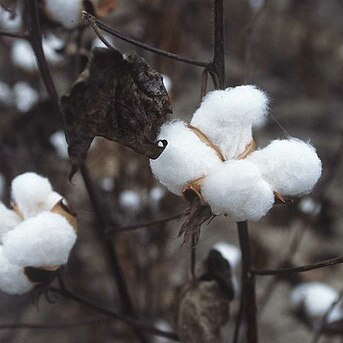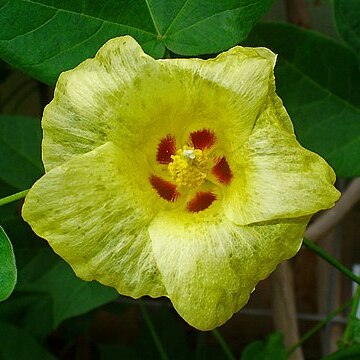Shrubs [trees], hairy or glabrate, not viscid. Stems erect [or procumbent]. Leaves: stipules persistent, subulate or linear to falcate; blade ovate, unlobed, shallowly lobed, or deeply parted, base subcordate or cordate, margins entire, surfaces glabrous or stellate-hairy, often with abaxial foliar nectaries. Inflorescences axillary, solitary flowers or flowers sympodially arranged; involucellar bractlets deciduous or persistent, 3, distinct. Flowers: calyx not accrescent, not inflated, lobes sometimes unribbed, ovate or triangular, glabrous or hairy; corolla cream or yellow [rose], sometimes fading rose, with or without dark spot at center; staminal column included; ovary 3–5-carpellate; style unbranched; stigmas decurrent-clavate. Fruits capsules, erect, not inflated, ovoid or subglobose to oblong, leathery, usually glabrous. Seeds [2–]24, densely comose to glabrate or glabrous. x = 13.
Herbs annual or perennial, sometimes shrubs; all parts irregularly dotted with dark oil glands. Leaf blades usually palmately 3-9-lobed, rarely entire. Flowers solitary, subterminal. Pedicel not articulated, usually with glands below insertion of epicalyx lobes. Epicalyx lobes 3(-7), foliaceous, glandular, free or connate at base, entire or toothed to deeply laciniate. Calyx cup-shaped, nearly truncate to 5-lobed. Corolla white or yellow, sometimes with purple center, large; petals 5, apex rounded. Staminal column with many anthers along entire length, apex truncate. Ovary 3-5-loculed; ovules 2 to many per locule; style short, rod-shaped, stigma clavate, 5-grooved. Capsule globose or ellipsoid, loculicidally dehiscent. Seeds globose, densely white long woolly, mixed with short hairs or without short hairs.
Bractlets of the epicalyx 3, large, foliaceous, cordate, ± incised; stamen-tube bearing anthers along the side but not at the summit; style undivided, with 5 subsessile stigmas; ovary 3–5-locular, ripening into a loculicidal capsule; seeds covered with long, usually white fibers. 20, warm reg.
Seeds usually with floss (or lint) and often also with fuzz (a shorter denser indumentum), sometimes nearly glabrous.
Ovary 3–5-locular; style clavate (with coherent stigmas) rarely slightly divided at the tip.
Small trees, shrubs, shrublets or perennial herbs dotted everywhere with black oil-glands.
Capsule loculicidally dehiscent; loculi several (rarely 2)-seeded.
Flowers in 1-several-flowered sympodial inflorescences.
Epicalyx of 3 usually foliaceous and persistent bracts.
Calyx cupuliform, truncate.


